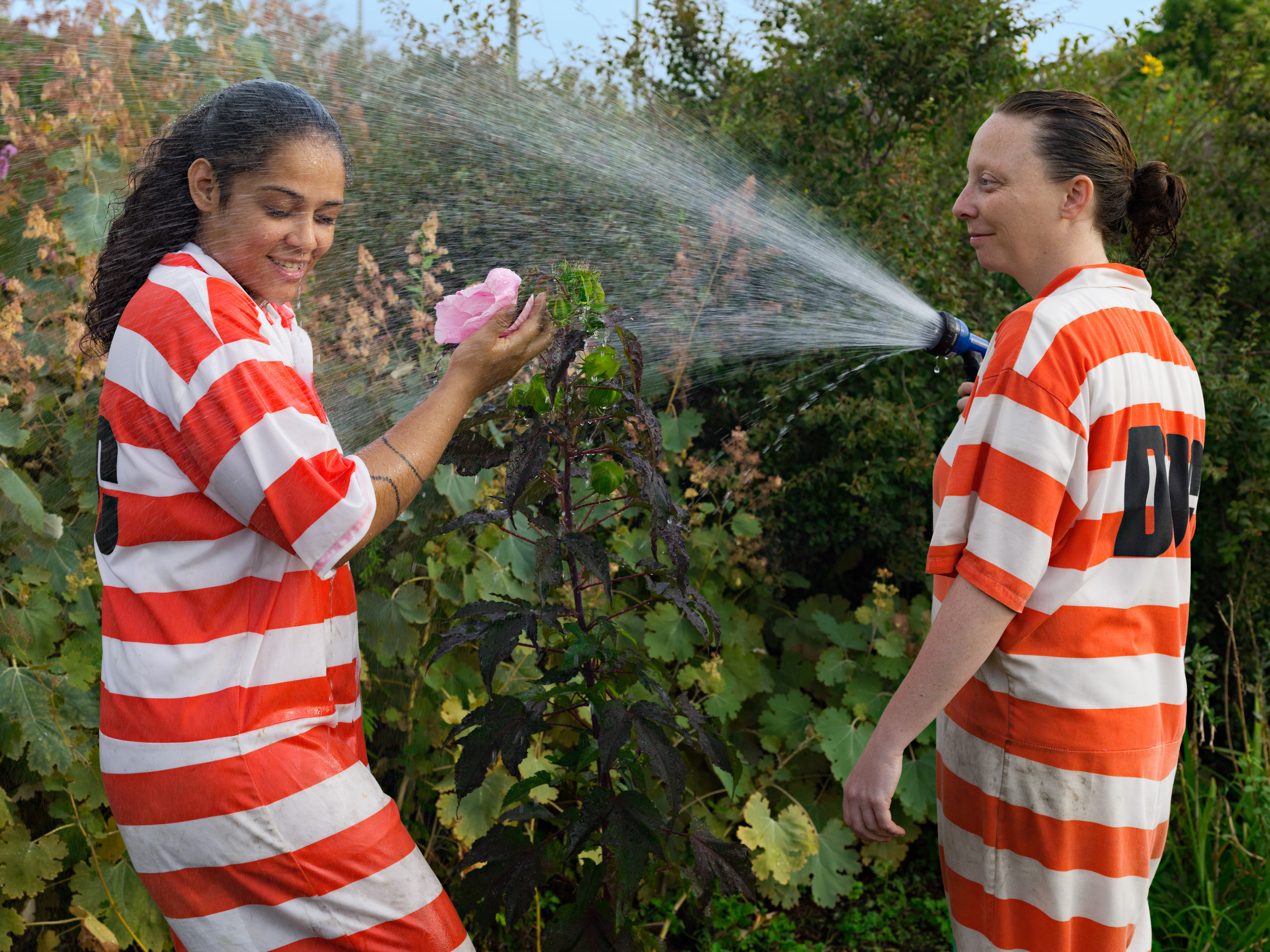
Inside The Rikers Island Prison Garden
Gardens have always been a symbol of our shared humanity– from the inspiring metaphors about wilt and rising again and again to the enduring capacity of a flower or greenery to make us feel at ease, there’s something innately transformative about the experience of being in nature.
New York Times-published photographer Lucas Foglia understands that capacity deeply, and in his new book, Human Nature (out now on Nazraeli Press), he explores the complex relationship between humans and the natural world– an aspect of modern living that is increasingly threatened by technology, indoor living, and even the government of the United States.
Below, we discuss the garden at Rikers and Foglia’s experience trying to capture the paradox between imprisonment and the sense of freedom that nature inherently inspires.

Vanessa and Lauren Watering, GreenHouse Program, Rikers Island Jail Complex, New York © Lucas Foglia. Courtesy of Fredericks & Freiser Gallery, New York
GC: What was the most surprising thing you witnessed at the Rikers Island Prison Garden?
LF: Rikers Island is New York City’s main jail complex. There are three organic gardens run by the Horticultural Society of New York, where prisoners tend flowers, fruits, and vegetables. Riots, lockdowns, beatings, and solitary confinement occur in the nearby buildings.
When I was visiting the gardens, a Guinea hen had flown over the barbed wire fence and hatched baby chicks. The prisoners were trying to lure the chicks back inside the fence to keep them safe.
There was one moment when Troy cupped a bird in his hand. The scale of his body, framed by the barbed wire, in contrast to the fragility of the bird and the intimacy of his gesture was surprising.

Troy Holding a Guinea Fowl Chick, GreenHouse Program, Rikers Island Jail Complex, New York © Lucas Foglia. Courtesy of Fredericks & Freiser Gallery, New York
GC: That’s very touching. How do you think gardens impact prisoners, based on what you saw?
LF: Prisoners who spend time working in the gardens are 40 percent less likely to return to prison after they are released. One inmate named Peter said, “If we could stay here all day that would be wonderful… It’s the only place we feel like human beings.”
GC: Who maintains the garden? e.g. Is there someone overseeing it in addition to prisoners?
LF: The gardens on Rikers Island are administered by Hilda Krus, the Director of the GreenHouse and Horticultural Therapy Programs for the Horticultural Society of New York. Hilda is, in my opinion, a magnanimous and wonderful person.

Jackie, Vanessa, Valerie, Lauren, Jakelyn, and Brenda Outside the Rose M. Singer Center, Rikers Island Jail Complex, New York © Lucas Foglia. Courtesy of Fredericks & Freiser Gallery, New York
GC: What challenges were you faced with, as a photographer, when trying to capture the essence of a project like this? Were there any restrictions placed on what you could/couldn’t see or bring into the facility?
LF: There are images that people expect to see in prisons, of inmates experiencing isolation, dehumanizing activities, violence, or loneliness. I was looking for moments that felt complex, surprising, positive, and intimate. I think it is vitally important to expose injustice. And I think it is vitally important to look for examples of a positive way forward.

Jonathan Holding Pruning Shears, GreenHouse Program, Rikers Island Jail Complex, New York © Lucas Foglia. Courtesy of Fredericks & Freiser Gallery, New York
GC: What do you think is the most “quintessential” photo that you took there and why? What were you hoping to convey?
LF: I want to make photographs that compel viewers to ask questions; to want to learn more.
The photograph of Lauren spraying water on Vanessa is both intimate and violent, both playful and serious. That is an example of the type of moment I was looking for.
Or the photograph of Jonathan holding pruning shears. He is so relaxed, lying down on a bench in the garden. His eye contact is comfortable and direct. And the pruning shears in his hand look vaguely like a gun.
GC: Can you briefly speak to what value you think prison gardens have for society as a whole?
LF: I think if we treat people like people then they are far more likely to act morally. Time in nature can teach prisoners that growth literally and figuratively comes from care.
The above photos and more will be on display that Foglia’s new exhibition at Aperture Gallery in New York City, which is on through March 7, 2018.

































